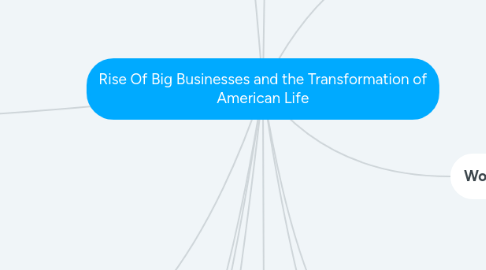
1. Industrial Growth
1.1. Major Industries
1.1.1. Railroad
1.1.1.1. Defeat of the Seasons
1.1.1.2. American Railway Association
1.1.1.3. Transcontinental Railroad
1.1.1.4. Union Pacific & Central Pacific
1.1.1.5. Cornelius Vanderbuilt
1.1.1.5.1. William Henry Vanderbuilt
1.1.1.6. Collis P. Huntington
1.1.1.7. John Morgan (Banker)
1.1.2. Steel
1.1.2.1. Andrew Carneige
1.1.2.1.1. John Morgan
1.1.3. Oil
1.1.3.1. Edwin L. Drake
1.1.3.2. John D. Rockefeller
1.1.3.2.1. Standard Oil Company
2. Ethical and Unethical Practices
2.1. Ethical
2.1.1. Becoming a Corporation
2.1.2. Vertical Intergation
2.1.3. Horizontal Intergation
2.2. Unethical
2.2.1. Pools
2.2.2. Trust
2.2.2.1. Rockefeller first trust
2.2.2.2. Legal In NJ
2.2.2.3. Standard Oil Trust
2.2.3. Gifts
3. Marketing and Development of a National Consumers Market
3.1. R.H Macy and Marshall Field
3.2. F.W Woolworth (5 & 10 cent Store)
3.3. Clearance Racks
3.4. Shelves
4. Men's Sense Of Masculinity
4.1. Unable to do physical Attributes
4.2. Coping
4.2.1. Emphasized elements of masculinity
4.3. Fraternities
5. New Immigration
5.1. Contract Labor Law
5.2. Immigration Process (Ellis Island)
5.3. Ethnic Communities
5.4. Asian Immigration
5.4.1. Railroads hired Chinese
5.4.2. Charles Crocker (Engineer for building central Pacific)
5.4.3. Chinese Experience
5.4.3.1. Society Isolation (China Town)
5.4.3.2. Laundryman Signature Trade
5.4.3.3. Chinese Prostitution
6. Urbanization/Living Conditions
6.1. Shift to agriculture to Industrialization
6.2. Dumbell tennement
6.3. factories polluted air
6.4. implement water filtration
7. Industrial Approaching Philanthropy
7.1. The Gospel Of Wealth
7.1.1. Andrew Carneige
8. Important Inventions
8.1. Gustance Swift
8.1.1. Effective Ice-cooled Railroad
8.2. Alexander Bell
8.2.1. Telephone
8.3. Thomas Edison
8.3.1. Electric Light Bulb
8.4. Revolutionized business transactions and changes in social life
9. Working, Middle, Elite Class
9.1. Elite
9.1.1. Display Wealth
9.1.2. Luxurious Homes
9.1.3. Opulent Parties
9.2. Working
9.2.1. 7 million people worked for wages
9.2.2. John Chambers (Nation of employees)
9.3. Middle Class
9.3.1. Mechanical Industry
10. Company Towns
10.1. Debt Slavery
10.2. Extraction Industries in Rural Areas
10.3. Scribe (Currency)
11. Work Environment
11.1. (1870) Women Were employed
11.2. Household dynamic changed
11.3. Female Work Experience Black vs. White
11.4. Child Labor
11.5. Factories vs. Argicultrure
11.6. Machines replaced skilled workers
12. Glided Age
12.1. Politics Dead Center
12.2. Republican (Union Veterans)
12.3. Democrats (Former Confederates)
12.4. Government Corruption
12.4.1. Political Rings
12.4.2. Machine
12.4.3. Influenced Government policy
